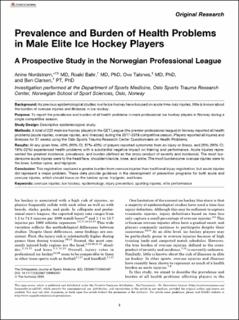Prevalence and Burden of Health Problems in Male Elite Ice Hockey Players : A Prospective Study in the Norwegian Professional League
Peer reviewed, Journal article
Published version
Permanent lenke
https://hdl.handle.net/11250/2663637Utgivelsesdato
2020Metadata
Vis full innførselSamlinger
- Artikler / Articles [2119]
- Publikasjoner fra Cristin [1107]
Originalversjon
Orthopaedic Journal of Sports Medicine (OJSM). 2020, 8(2), Artikkel 2325967120902407. 10.1177/2325967120902407Sammendrag
Background: As previous epidemiological studies in elite ice hockey have focused on acute time-loss injuries, little is known about the burden of overuse injuries and illnesses in ice hockey. Purpose: To report the prevalence and burden of all health problems in male professional ice hockey players in Norway during a single competitive season. Study Design: Descriptive epidemiological study. Methods: A total of 225 male ice hockey players in the GET League (the premier professional league) in Norway reported all health problems (acute injuries, overuse injuries, and illnesses) during the 2017-2018 competitive season. Players reported all injuries and illnesses for 31 weeks using the Oslo Sports Trauma Research Center Questionnaire on Health Problems. Results: At any given time, 40% (95% CI, 37%-43%) of players reported symptoms from an injury or illness, and 20% (95% CI, 19%-22%) experienced health problems with a substantial negative impact on training and performance. Acute injuries represented the greatest incidence, prevalence, and burden (defined as the cross-product of severity and incidence). The most burdensome acute injuries were to the head/face, shoulder/clavicle, knee, and ankle. The most burdensome overuse injuries were to the knee, lumbar spine, and hip/groin. Conclusion: This registration captured a greater burden from overuse injuries than traditional injury registration, but acute injuries did represent a major problem. These data provide guidance in the development of prevention programs for both acute and overuse injuries, which should focus on the lumbar spine, hip/groin, and knee.
Beskrivelse
This open-access article is published and distributed under the Creative Commons Attribution - NonCommercial - No Derivatives License (https://creativecommons.org/licenses/by-nc-nd/4.0/), which permits the noncommercial use, distribution, and reproduction of the article in any medium, provided the original author and source are credited. You may not alter, transform, or build upon this article without the permission of the Author(s). For article reuse guidelines, please visit SAGE’s website at http://www.sagepub.com/journals-permissions.
